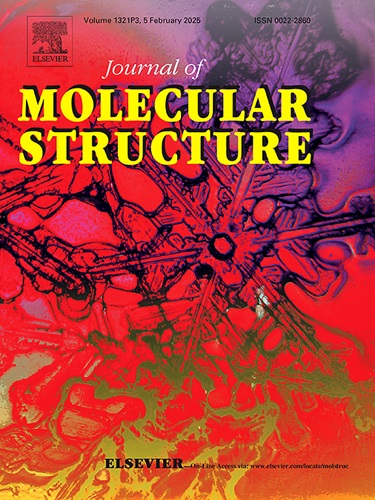Tutton salt (NH4)2Fe(SO4)2(H2O)6: A promising crystal for bandpass filter and solar-blind devices
IF 4
2区 化学
Q2 CHEMISTRY, PHYSICAL
引用次数: 0
Abstract
Tutton salt (NH4)2Fe(SO4)2(H2O)6 was successfully synthesized by slow solvent evaporation from a saturated aqueous solution. The structural, chemical, vibrational, and optical properties of the compound were thoroughly investigated. Computational studies were performed to support experimental data, utilizing Hirshfeld surface analysis, crystal voids, interaction energy, and density functional theory (DFT) calculations. The (NH4)2Fe(SO4)2(H2O)6 crystallizes in a monoclinic structure of P21/a space group, with solid formation occurring at an acidic pH of 3.6. Hirshfeld surface analysis revealed key intermolecular interactions, with H···O/O···H contacts predominating. The low void percentage in the primitive cell suggests high lattice energies between the [Fe(H2O)6]2+, [SO4]2–, and NH4+ molecular layers forming the salt. The stability of crystals was also assessed across different pH environments. The crystals remain physically and chemically stable at neutral pH, whereas acidic and alkaline environments induced mass loss and passive surface oxidation, respectively. Vibrational analysis, carried out using Raman and infrared spectroscopy, was compared with DFT-calculated spectra for more accurate spectral assignments. Several other parameters were also evaluated, including geometric (bond length and angle), thermodynamic (free energy, enthalpy, entropy, and Debye temperature), and electronic (band structure and projected density of states). Optical studies revealed features typical of materials used in solar-blind technology and bandpass filters, with absorbance and transmittance spectra indicating potential applications. (NH4)2Fe(SO4)2(H2O)6 demonstrated promising properties for solar-blind photodetectors operating in the 190–270 nm interval. Furthermore, it can be effectively useful as a bandpass filter within the 418–800 nm spectral range.

塔顿盐(NH4)2Fe(SO4)2(H2O)6:一种用于带通滤波器和太阳盲器件的有前途的晶体
以饱和水溶液为原料,采用缓慢溶剂蒸发法制备了塔顿盐(NH4)2Fe(SO4)2(H2O)6。研究了该化合物的结构、化学、振动和光学性质。利用Hirshfeld表面分析、晶体空洞、相互作用能和密度泛函理论(DFT)计算,进行了计算研究来支持实验数据。(NH4)2Fe(SO4)2(H2O)6结晶为P21/a空间基单斜晶型,在酸性pH为3.6时形成固体。Hirshfeld表面分析揭示了关键的分子间相互作用,以H··O/O··H接触为主。原始细胞中的低空隙率表明形成盐的[Fe(H2O)6]2+、[SO4]2 -和NH4+分子层之间的晶格能较高。还评估了晶体在不同pH环境下的稳定性。晶体在中性pH下保持物理和化学稳定,而酸性和碱性环境分别引起质量损失和被动表面氧化。利用拉曼光谱和红外光谱进行了振动分析,比较了dft计算的光谱,以获得更精确的光谱分配。其他几个参数也被评估,包括几何(键长和角度)、热力学(自由能、焓、熵和德拜温度)和电子(能带结构和状态的投影密度)。光学研究揭示了用于太阳盲技术和带通滤光片的材料的典型特征,吸收光谱和透射光谱表明了潜在的应用。(NH4)2Fe(SO4)2(H2O)6表现出在190 ~ 270 nm范围内工作的太阳盲光电探测器的良好性能。此外,它可以有效地用作418 - 800nm光谱范围内的带通滤波器。
本文章由计算机程序翻译,如有差异,请以英文原文为准。
求助全文
约1分钟内获得全文
求助全文
来源期刊

Journal of Molecular Structure
化学-物理化学
CiteScore
7.10
自引率
15.80%
发文量
2384
审稿时长
45 days
期刊介绍:
The Journal of Molecular Structure is dedicated to the publication of full-length articles and review papers, providing important new structural information on all types of chemical species including:
• Stable and unstable molecules in all types of environments (vapour, molecular beam, liquid, solution, liquid crystal, solid state, matrix-isolated, surface-absorbed etc.)
• Chemical intermediates
• Molecules in excited states
• Biological molecules
• Polymers.
The methods used may include any combination of spectroscopic and non-spectroscopic techniques, for example:
• Infrared spectroscopy (mid, far, near)
• Raman spectroscopy and non-linear Raman methods (CARS, etc.)
• Electronic absorption spectroscopy
• Optical rotatory dispersion and circular dichroism
• Fluorescence and phosphorescence techniques
• Electron spectroscopies (PES, XPS), EXAFS, etc.
• Microwave spectroscopy
• Electron diffraction
• NMR and ESR spectroscopies
• Mössbauer spectroscopy
• X-ray crystallography
• Charge Density Analyses
• Computational Studies (supplementing experimental methods)
We encourage publications combining theoretical and experimental approaches. The structural insights gained by the studies should be correlated with the properties, activity and/ or reactivity of the molecule under investigation and the relevance of this molecule and its implications should be discussed.
 求助内容:
求助内容: 应助结果提醒方式:
应助结果提醒方式:


